Vanuatu Beef for the Organic Market
The Vanuatu Series > FM 107 > Vanuatu Beef > Coconut Crabs > Ambrym > Casino
The Captain knows a thing or two about beef. But he would also prefer to forget his venture into the Japanese meat market a few years ago. Who knew the Japanese wouldn't want to wrap their chopsticks around a nice slab of Steakum?
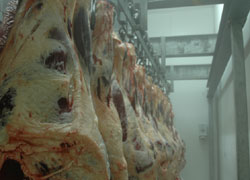 This week he's sinking his teeth into Vanuatu beef. Get in line, folks, the Captain is manning the grill.
This week he's sinking his teeth into Vanuatu beef. Get in line, folks, the Captain is manning the grill.
Lunch break is over.
The first head of cattle enters the steel chamber. The stun-gun operator attempts to position the silver pistol-like instrument between the eyes of the jostling animal. Then...
Wham! It drops to the floor, hooves clanking against the sides.
Quickly, workers in white smocks stained in bright red attach a chain to its leg. The animal is hoisted up and then along a steel rail.
As one of the workers draws a thin, foot-long blade from his belt to slice the animal's throat, the next head arrives inside the walled enclosure. An echoing moo then begins rolling through the slaughterhouse.
"The overall concept is this," explains Janette James, general manager of Port Vila's beef processor Vanuatu Abatoirs Limited (VAL-Pacific), "What does Vanuatu have? We have tourism, kava, timber...and beef. It is one of the main export earners."
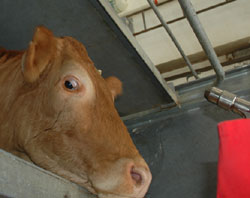 Not only that, this Pacific Island nation has organic beef - an increasingly desirable commodity on the international market, one that this former joint colony of England and France hopes to exploit if it can only procure more cattle.
Not only that, this Pacific Island nation has organic beef - an increasingly desirable commodity on the international market, one that this former joint colony of England and France hopes to exploit if it can only procure more cattle.
Between 8,000 and 9,000 head of cattle are processed annually at VAL, with two thirds being for the local market and the rest for export. Australia, the Solomon Islands, and Papua New Guinea are typical overseas destinations.
Farms on Efate or those on the outer islands, primarily Santo or Malapula, fatten the cattle on local flora. With year-round rain and a volcanic landscape, Vanuatu's soil is arable and nitrogen-rich - a combination that produces grasses which are long all year.
"The cattle," explains James, "are not eating down at the ground level, where the parasites are. Cats, dogs, goats, and pigs all have parasites. They eat closer to the earth. Our grass is so lush generally. The cattle are nibbling the nice green bits off the top."
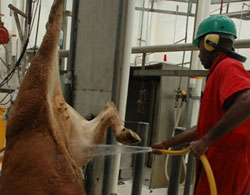 Grain feed is not used, which renders the likelihood of BSE (Bovine Spongiform Encephalopathy) occurring to be fairly remote.
Grain feed is not used, which renders the likelihood of BSE (Bovine Spongiform Encephalopathy) occurring to be fairly remote.
"You couldn't say it is impossible," James cautions, "because anyone who says something is impossible is asking for a problem."
This lack of diseases is one reason annual exports of chilled and aged frozen beef increased by 11% for the year ending 2005, says a report issued by the Vanuatu Quarantine and Inspection Services. Japan, which imported 34% more than the year before, has suffered from multiple cases of BSE in recent years.
Beef exports accounted for 6.5% of Vanuatu's total for 2002.
James sees the international markets, especially that for organic beef, as the future.
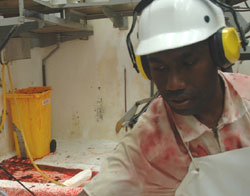 "Organic branding in developed markets like the European Union," says Dr. Dale Hamilton, acting director of Vanuatu Quarantine and Inspection Services, "is seen as providing added value to beef."
"Organic branding in developed markets like the European Union," says Dr. Dale Hamilton, acting director of Vanuatu Quarantine and Inspection Services, "is seen as providing added value to beef."
Organic beef is that which has been raised in an environment free of hormone injections and chemical pesticides. But only "organically certified" beef can qualify as organic beef.
One third of VAL's exports are organic. Each month one container (approximately 75 head of cattle) is shipped to Australia, where VAL has organic certification. The processor hopes to get organic certification in New Zealand in the near future.
VAL ships its organic products at an average premium of 20% over non-organic. Though James is quick to point out that the percentage can be higher for top cuts, such as tenderloin and rump.
Expansion into international markets, however, has its problems. For one, VAL is a service abatoir (slaughtering facility) for the local butchers, with whom preference is placed. This was the basic tenet at the entity's founding in 1974.
"If the butchers," supposes James, "want to put through 80 animals, which is our capacity based on the space available in our chillers, we can't kill any for export."
But that is an issue only if cattle exist for export. Often the farmers can't keep up with the market demand.
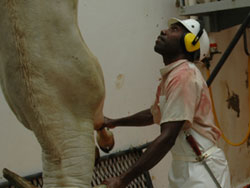 "We are having periods," she says, "where during a whole week we are killing for the local butchers. We haven't got a situation where we have cattle available just to have the staff busy."
"We are having periods," she says, "where during a whole week we are killing for the local butchers. We haven't got a situation where we have cattle available just to have the staff busy."
The cattle arrive at VAL the day before, whereby their insides are cleaned out - "Elimination before being eliminated," James says. The first "knock" comes the following morning at 7am.
"I do feel a bit squeamish," admits James, "when I look into the animal's eyes before its slaughtered. But my job is to make sure it's done efficiently and quickly and causes the least pain and trauma to the animal."
Any stress inflicted before killing, she emphasizes, is going to show up in the quality of the meat. "We are going to end up with non-tender meat."
Once killed, the animal's head and hide are removed with knives and rotating handsaws. Workers, whose typical injuries amount to cut hands, advance the animal down an assembly line of hooks and hoses that proceeds over a slick, blood-splattered floor.
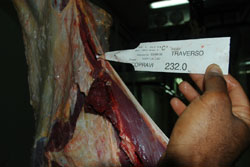 At the end of the procession is a computer developed by Triton Commercial Systems. As machinery hums, high-pressure hoses hiss, and fans rotate overhead, a worker attaches a barcode tag from the computer to each processed carcass.
At the end of the procession is a computer developed by Triton Commercial Systems. As machinery hums, high-pressure hoses hiss, and fans rotate overhead, a worker attaches a barcode tag from the computer to each processed carcass.
Guaranteeing organic certification is vital to shipping organic beef. The tags allow for tracking of each piece of beef as it moves from the slaughterhouse to the customer. In days past, the beef was marked by hand.
Though James refers to the business as having a "cowboy environment" due to the tactics employed by the butchers - for example, demanding lower kill fees or showing up at VAL with their cattle unannounced - the native New Zealander takes pride in Vanuatu beef. A sign on her office wall claims Vanuatu beef is "the best in the world."
When cooked, the beef appears a bit stringy and has a unique taste, certainly a bit more gamey than other cuts.
"It is a drug," James says. "I have it once every two weeks. It is addictive. You long to eat it."
The Vanuatu Series > FM 107 > Vanuatu Beef > Coconut Crabs > Ambrym > Casino

